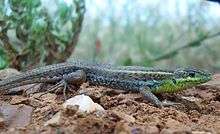Ophisops elegans
Ophisops elegans, commonly known as the snake-eyed lizard, is a species of lizard in the family Lacertidae. The species is endemic to the Mediterranean region and Central Asia. There are nine recognized subspecies.
| Ophisops elegans | |
|---|---|
 | |
| Scientific classification | |
| Kingdom: | Animalia |
| Phylum: | Chordata |
| Class: | Reptilia |
| Order: | Squamata |
| Family: | Lacertidae |
| Genus: | Ophisops |
| Species: | O. elegans |
| Binomial name | |
| Ophisops elegans Ménétries, 1832 | |
Description
O. elegans has the following distinguishing characters: Head moderate, feebly depressed. Upper head-shields smooth or slightly rugose; nostril lateral, pierced between on upper and a lower nasal, and followed by one or two postnasals; frontonasal single; four supra-oculars, first and fourth very small, the two principal separated from the supraciliaries by a series of granules: occipital small, in contact with or separated from the interparietal; subocular bordering the lip, normally between the fourth and fifth upper labials; temporal scales small, smooth; usually two large supratemporal shields bordering the parietal; a large tympanic shield. A. gular fold may be distinguishable; collar absent or feebly marked. Dorsal scales variable in size, as large as or larger than the laterals; 30 to 40 scales round the middle of the body, ventrals included. A more or less enlarged postero-median preanal plate. The hind limb reaches about the ear in the male, the shoulder or a little beyond in the female. 7 to 12 (usually 9 to 11) femoral pores on each side. Tail about twice as long as head and body. Olive or bronzy above, with black spots usually forming longitudinal series, sometimes forming a network; frequently and or two light longitudinal streaks on each side; lower surfaces white.[2]
From snout to vent 2 inches (5 cm); tail 4 inches (10 cm).
Subspecies
The following nine subspecies are recognized as being valid, including the nominotypical subspecies.[3]
- Ophisops elegans basoglui Baran & Budak, 1978
- Ophisops elegans blanfordi Schmidt, 1939
- Ophisops elegans budakibarani Tok, Afsar, Yakin, Ayaz & Çiçek, 2017
- Ophisops elegans centralanatoliae Bodenheimer, 1944
- Ophisops elegans ehrenbergerii (Wiegmann, 1835)
- Ophisops elegans elegans Ménétries, 1832
- Ophisops elegans macrodactylus Berthold, 1840
- Ophisops elegans persicus Boulenger, 1918
- Ophisops elegans schlueteri Boettger, 1880
Nota bene: A trinomial authority in parentheses indicates that the subspecies was originally described in a genus other than Ophisops.
Etymology
The subspecific name, schlueteri, is in honor of Wilhelm Schlüter, who was a German dealer of natural history specimens.[4]
Geographic range
O. elegans is found in E Georgia, Armenia, Azerbaijan, SE Bulgaria, NE Greece (Lesbos, Limnos, Chios, Samos, Samothraki, Agathonisi, Psara), Cyprus, Turkey, Algeria, Libya, Egypt,[5] W Syria, Lebanon, Israel, W Jordan, Iraq, Iran (Kavir desert), N Pakistan, NW India.
Races:
- O. e. basoglui – S Anatolia
- O. e. blanfordi – Pakistan
- O. e. centralanatolia – C Anatolia
- O. e. ehrenbergi – Kalymnos, Lesbos etc.
- O. e. elegans – Turkey (including Anatolia)
- O. e. macrodactylus – W Turkey, Greece (Lesbos etc.)
- O. e. schlueteri – Cyprus
Type locality: Baku, Azerbaijan.
Habitat
The preferred natural habitats of O. elegans are grassland, shrubland and forest, at altitudes of 400–2,000 m (1,300–6,600 ft).[1]
Reproduction
References
- Lymberakis P et al. (2009). "Ophisops elegans ". The IUCN Red List of Threatened Species 2009: e.T157279A5068693. Downloaded on 29 February 2020.
- Boulenger GA (1890). The Fauna of British India, Including Ceylon and Burma. Reptilia and Batrachia. London: Secretary of State for India in Council. (Taylor and Francis, printers). xviii + 541 pp. (Ophisops elegans, p. 175).
- Species Ophisops elegans at The Reptile Database www.reptile-database.org.
- Beolens, Bo; Watkins, Michael; Grayson, Michael (2011). The Eponym Dictionary of Reptiles. Baltimore: Johns Hopkins University Press. xiii + 296 pp. ISBN 978-1-4214-0135-5. (Ophisops elegans schlueteri, p. 235).
- Baha el Din, Sherif (2006). A Guide to Reptiles & Amphibians of Egypt. Cairo: The American University in Cairo Press. ISBN 978-9774249792.
Further reading
- Bischoff W (1974). "Echsen des Kaukasus, Teil 7. Die Europäische Schlangenaugen-Eidechse Ophisops elegans Menetries 1832 ". Aquar. Terr. B21: 340-343. (in German).
- Lantz AL (1930). "Note sur la forme typique d' O. elegans Ménétries. Bull. Mus. Géorgie 6: 31-42. (in French).
- Ménétries E (1832). Catalogue raisonné des objets de zoologie recueillis dans un voyage au caucase et jusqu'aux frontières actuelles de la Perse. Saint Petersburg, Russia: L'Académie Impériale des Sciences de St.-Pétersbourg. 330 pp. (Ophisops elegans, new species, pp. 63-64). (in French).
- Olgun, Kurtuluş; Tok, Cemal Varol (1999). "Ihlara Vadisi (Aksaray)'nden toplanan Ophisops elegans (Sauria: Lacertidae) ornekleri hakkinda ". Turkish Journal of Zoology 23 (Turkish Supplement 3): 807-810. (in Turkish).
- Schlüter U (2003). "Zur Kenntnis des Westlichen Schlangenauges, Ophisops occidentalis (Boulenger 1887)". Elaphe 11 (3): 56-63. (in German).
- Tok, Cemal Varol; Kumlutas, Yusuf; Türkozan, Oguz (1997). "On Specimens of Ophisops elegans Menetries 1832, (Sauria; Lacertidae) Collected From Hatay, Turkey". Turk. J. Zool. 21: 195-203.
External links
- Ophisops elegans at The Checklist of Armenia's Amphibians and Reptiles at Tadevosyan's Herpetological Resources. Accessed 30 March 2007.
